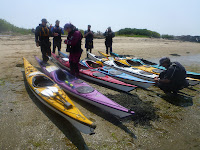I spent the last four days in the Boothbay area, taking part in another ACA Instructor Development Workshop. I did my first IDW a year ago, preparing me to instruct at level 3, and in the fall I assessed and became certified. I plan on teaching for awhile before assessing for level 4, but it was great to start the summer with four days of reinforcing personal paddling skills and teaching methods.
The course was taught by Todd Wright and Carl Ladd, who were joined on our last day by John Carmody.
(click on photos for bigger versions)
Boothbay is near a great variety of paddling environments, so, depending on the weather and conditions and what you hope to do, you could venture out to open ocean islands, rocky ledges or sandy beaches with good surf. We spent our time in tidal rivers, finding a bit more current each day until the last, when we played in the tidal race at the mouth of the Kennebec.
We also paddled on Knubble Bay, Lower Hell Gate and the Sheepscot River. We found calm stretches as well as places where the tide squeezes large volumes of ocean through narrow gaps between islands- good places to teach and be taught, but also just some really nice paddling.
I wasn't there to take pictures, and since we spent plenty of time in the water practicing rescues and such, I have a lot of blurry, water on the lens shots.
I also have pages and pages of notes that I wrote down each evening, trying to make sense of all we'd done. At the beginning of the class we talked about what kind of learners we are, and I half-jokingly said "slow." But I do seem to get things through layers of being taught, experience, and then reflecting upon it. Often enough I wonder why I keep this blog, and in a way I think it's become one layer of the process, forcing me to reflect upon things that might otherwise slip away.
I won't be offering much here in the way of reflection, but as with the trips we take, my kayaking learning process involves at least three stages. There's the anticipation beforehand, in which we prepare, try to get ourselves as ready as we can be. Maybe we brush-up on strokes, or study some of the more academic aspects like tidal or weather prediction or navigation. There's the class itself. It's a mix of fun and hard work. Some of it is instruction and feedback directed at us... and some of it is us directing instruction and feedback to others. Sometimes you get put on the spot and discover that your method needs a little work, or that you don't own the skill or subject as well as you could. Sometimes things go wrong, but it's the perfect time for that to happen. We probably learn the most when things don't go smoothly (like the husky tow in current, when one of the rescuers capsizes and we're all drifting in a tangle of ropes).
Then, after the class, you hope it comes together with the other layers of experience and instruction. We're given an action plan- an inventory of our strengths and weaknesses with suggestions for steps to improve. It can be overwhelming at times. A year ago I came home with a lot to improve, but ideally, every time you go paddling, you find yourself working on it. I can only wonder how, a year from now, I'll look back on what I'm doing now.

























3 comments:
Nicely done Michael, thanks for the great post and images.
Love the first photo.
Another awesome post. That first photo could win an award. OMG, fog!
Post a Comment